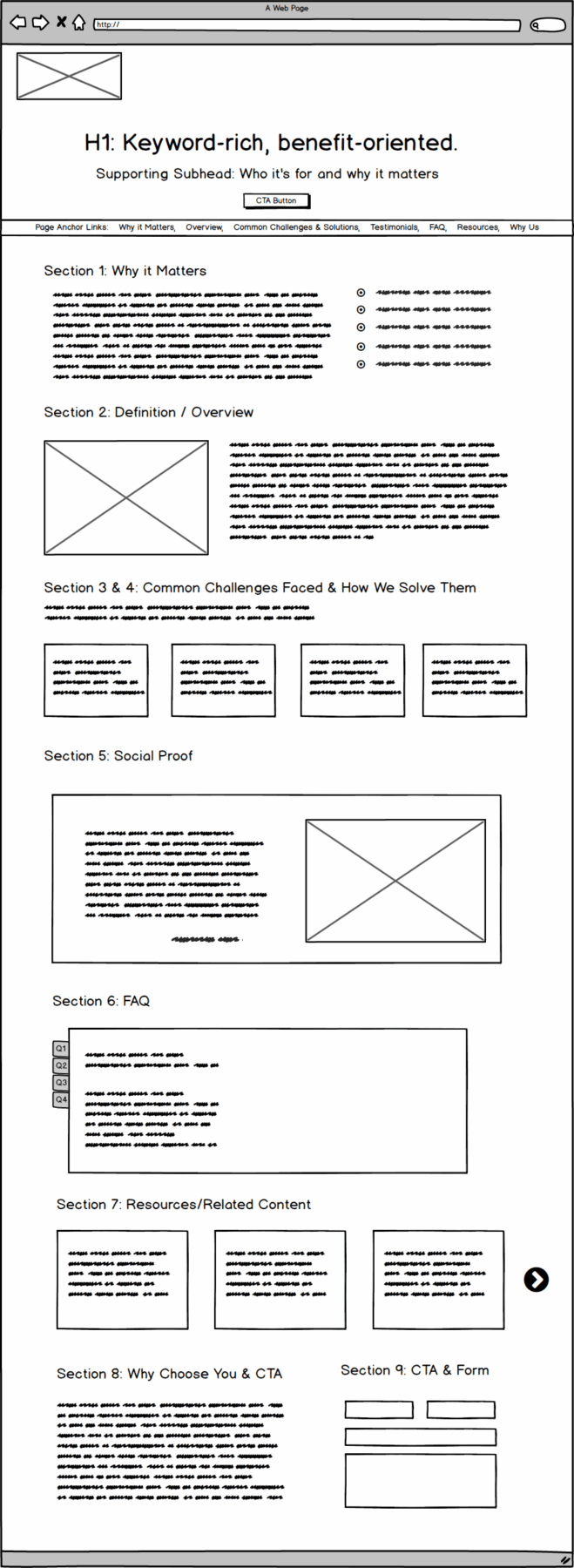AERPOWER Blog
We really, really love what we do.
In aviation marketing and aerospace and defense industries, content often becomes fragmented. Case studies live on separate pages. Technical blogs drift away from service content. Visitors don’t know where to start—and marketers don’t know what to optimize.
That disconnection is costing visibility, trust, and leads.
Imagine a program manager or procurement lead lands on your site. They’re evaluating suppliers. You have helpful blogs. A detailed service page. A case study with strong results. But none of it is connected. They can’t find the full picture—so they move on.
A pillar page is how you fix that.
A pillar page is a long-form, centralized web page that comprehensively covers a core topic and links out to related content.
Think of it as a strategic content hub. It doesn’t just summarize what you offer—it organizes everything that supports a specific product, service, market, or problem area.
It typically links to:
– Product or service pages
– Related blog articles
– Case studies
– Glossaries or tools
– Gated or downloadable resources
In aviation marketing and aerospace and defense, pillar pages bring structure to complex offerings. They make your value clear, your expertise easy to explore, and your site easier to rank.
1. Search engines and AI prioritize structured content
Search models like Google SGE, ChatGPT, and Perplexity extract content based on context. A pillar page gives them exactly what they want: depth, clarity, and interlinked topics.
2. Your buyers want direction, not just information
A&D buyers are technical, risk-averse, and time-strapped. They don’t want 20 tabs open to figure out what you do. A pillar page delivers a curated, high-trust experience.
3. You already have the content—it’s just scattered
Many A&D companies already have blogs, case studies, and service pages. The problem isn’t content creation. It’s lack of structure. A pillar page pulls it all together.
4. It supports every stage of the buyer journey
From education to evaluation to conversion, a good pillar page guides visitors through the funnel. It can even replace or enhance your traditional landing pages.
The following categories are starting points—each one can be shaped into a tailored pillar page based on your audience, offering, or strategic goal.
Key Service Pillars
– Engineering Services
– Component Manufacturing
– MRO Support
Problem-Focused Pillars
– Emissions Compliance
– Supply Chain Risk
– Inspection Accuracy
Customer Vertical Pillars
– Commercial Aviation
– Military Ground Equipment
– Space Systems
Example:
Component Manufacturing: A pillar titled “Modern Aerospace Components: From Spec to Certification” might link to your manufacturing services, material standards blog, a heat treatment case study, and a glossary of NADCAP processes.
A great pillar page:
– Has a clear, benefit-oriented hero section
– Covers the topic in depth, not just a summary
– Interlinks to supporting content (blogs, case studies, services)
– Builds trust with proof (logos, quotes, case studies, or client stories)
– Supports conversion with CTAs and clear navigation
– Use one H1 and clear H2/H3 hierarchy
– Define the topic in the first 100 words
– Write 1,500+ words of rich, specific content
– Include a FAQ section with schema
– Add visuals, diagrams, and examples where helpful
– Link to product/service pages, blogs, and resources
– Include proof points like testimonials or metrics
– Repeat your CTA mid-page and at the end
– Make the page mobile-friendly and fast-loading
Not sure if your current page qualifies as a strong pillar? We offer quick strategic reviews to help you identify gaps and opportunities—reach out to schedule yours.
1. Hero Section – A strong opening with a clear headline and benefit statement to capture attention immediately.
2. Why It Matters – Explain the business or industry relevance of the topic to set the stage for deeper engagement.
3. Definition / Overview – Provide a concise, jargon-free definition or explanation of the topic.
4. Common Challenges– List key pain points or industry frustrations that your audience can relate to.
5. How You Solve It – Describe your company’s unique solution, approach, or methodology.
6. Social Proof– Add credibility with client quotes, case studies, testimonials, or results.
7. Resources & Related Content – Link to blog posts, videos, whitepapers, and tools that deepen the reader’s understanding.
8. FAQs – Answer common objections, concerns, or questions to support decision-making.
9. Why Choose [Your Company] – Highlight your differentiators, capabilities, and reasons clients trust you.
10. Call to Action – End with a clear prompt for the next step—book a call, download a guide, or get a quote.

Most aerospace and defense companies aren’t short on content—they’re just not putting it on their websites in a way that’s structured, accessible, or strategic.
A pillar page turns your blog posts, product pages, and case studies into an organized experience that:
– Drives organic visibility
– Guides buyers
– Earns trust
– Converts leads
Start with one core topic that matters to your business, and build your first pillar from there. It’s not just content architecture. It’s content strategy.
Need help planning your first pillar page? Let’s map it out together.
Sarah Stanczyk is the Digital Marketing Director at AERPOWER Aviation Marketing, a strategic partner to aerospace and defense companies navigating complex, long-cycle sales. With 12+ years of experience in B2B and technical markets, she helps brands clarify their positioning, amplify their visibility, and align marketing with how real buyers evaluate and decide.